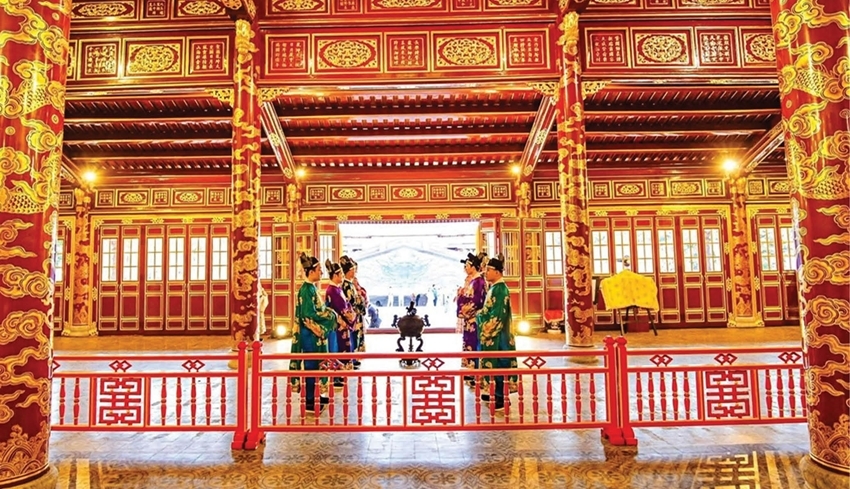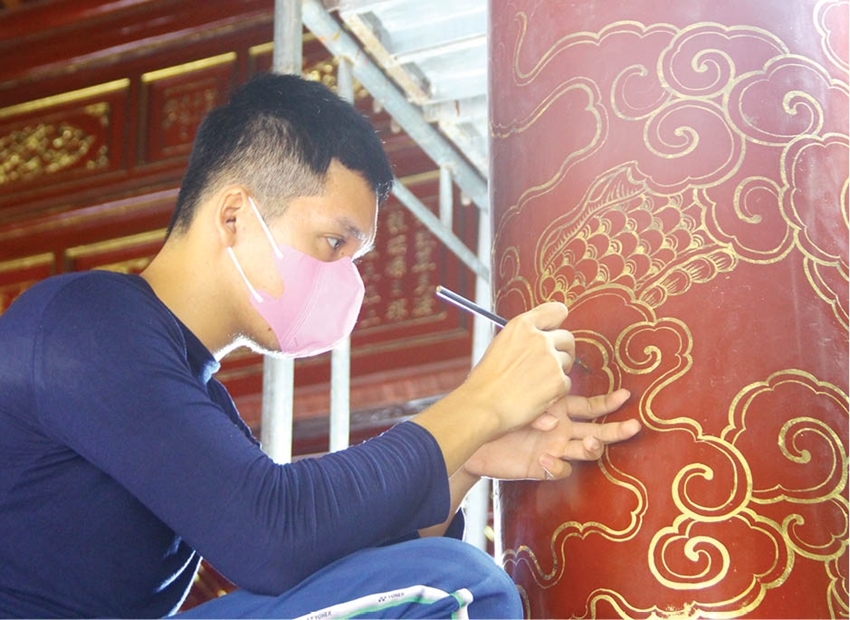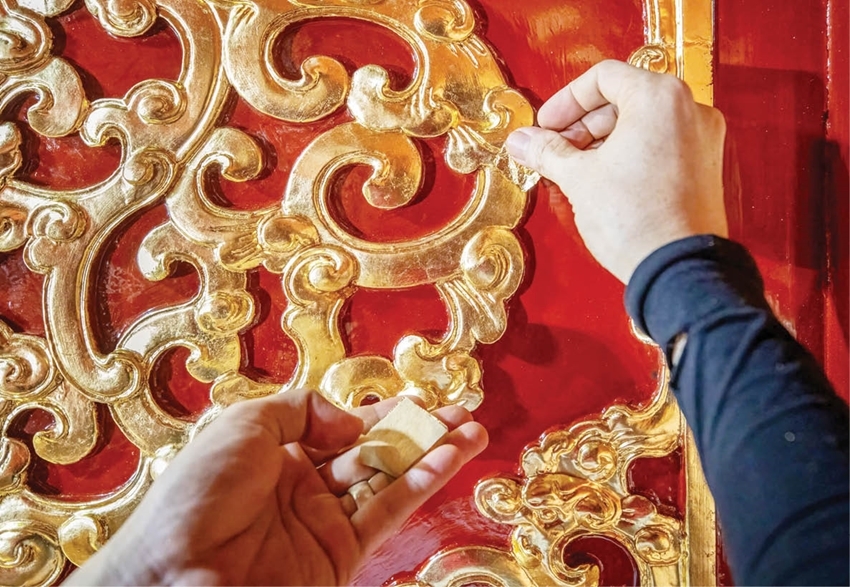 |
| Gorgeous Thai Hoa Palace |
In the vast space of the relic, Dang Tan and his colleagues were meticulously separating the thin 24-carat gold layers. He looked so focused that I didn't dare to disturb or interrupt him. Now and then, a thin sheet of gold sticked to his hands, which took him lots of time and energy to take it off.
"This is real gold, so we have to avoid loss to the minimum,” said he briefly. With more than 20 years of experience in charge of the technical stage in repair and restoration of relics, Tan is quite knowledgeable about lacquering and gilding. However, he’s very modest and somewhat hesitant in talking about this extremely difficult stage.
Lacquering and gilding is an ancient craft in many countries all over the world, and its procedure remains to date. Especially, when many historical relics in Hue are being repaired or restored, this craft is revived with the participation of many skillful artisans across the country.
According to Tan, at first sight, sticking gold sheets on wooden structures seems simple and easy. But to do that, people have to carry out various steps, from selecting materials to lacquering and gilding in order to make the interior of relics look more splendid and gorgeous.
 |
| Meticulously taking care of details. Photo: Ngoc Nhi |
"Lacquering and gilding requires many meticulous steps difficult to describe fully. Simply put, when the lacquer layers are just dry, craftsmen stick thin gold sheets like fish scales, then with a special tool, they remove unnecessary parts. The steps vary, depending on each object they’re working on. That requires craftsmen various skills,” said Tan.
We had many opportunities to watch the craftsmen lacquering and gilding the interior when the Thai Hoa palace, where the 13 emperors of the Nguyen dynasty had been coronated, was overall repaired and embellished. In particular, up to 66 out of 80 columns of the palace are embellished with lacquered and gilded dragons. These columns had experienced various steps such as applying primer, polishing, drawing, painting, etc.
 |
| Lacquered and gilded decorative patterns |
It is the lacquered and gilded wooden structures that make the constructions of the Nguyen dynasty unique and typical. According to artisan Phan Canh Quang Thuan (Hue City), materials and tools needed for lacquering and gilding are paint extracted from resin of a kind of tree in mountainous area in the North, gold, color powder, white cloth, ground wood, and others. Components must be processed carefully and thoroughly before being lacquered and gilded.
“Gilding is the process of sticking very thin layers of gold on the wooden surface to create the natural yellow color. The color changes according to the degree of “ripeness” of the paint. Lacquer forms the background and gold makes details. The most difficult step while gilding are avoiding ruining sharp carvings and how to make gold stay firmly with the lacquer layers,” said Thuan.
With time, lacquered and gilded objects and decorative patterns in Hue relics have become valuable documents, typical for each historical stage. Lacquered and gilded parts contribute to the majestic look of the construction. Artisans in lacquering and gilding not only have skillful hands but must also be knowledgeable about the role and position of the components as well as the historical value of each object.
Artisan Ngo Dinh Trong, head of the painting team of the Thai Hoa project, stressed the passion and the efforts of the craftsmen. In order to do this, they have to learn and be trained for good. Trong’s team includes many skillful craftsmen trained by the late painter Do Ky Hoang, lecturer at Hue University of Arts.
"The important thing is to try to keep the architectural construction intact. Lacquered and gilded patterns are a very important part of the relics with their own mission. Craftsmen thus need both mind and ability,” said Trong.
Lacquering and gilding is an art. Only skillful artisans can do that. “Experience plays a very important role. Depending on the weather, they calculate the proper time between lacquering layers. As for decorative details, when over 10 layers of lacquer are applied, their sharpness is affected. It’s gilding that resolves the “conflict” between painting and carving. That is the reason why gilding can always be seen on structures with carvings,” said researcher Pham Duc Thanh Dung.
Lacquering and gilding technology, through the hands of talented artisans, has become an art. It is even more significant when it’s widely used in restoration, embellishment and restoration of relics in Hue.